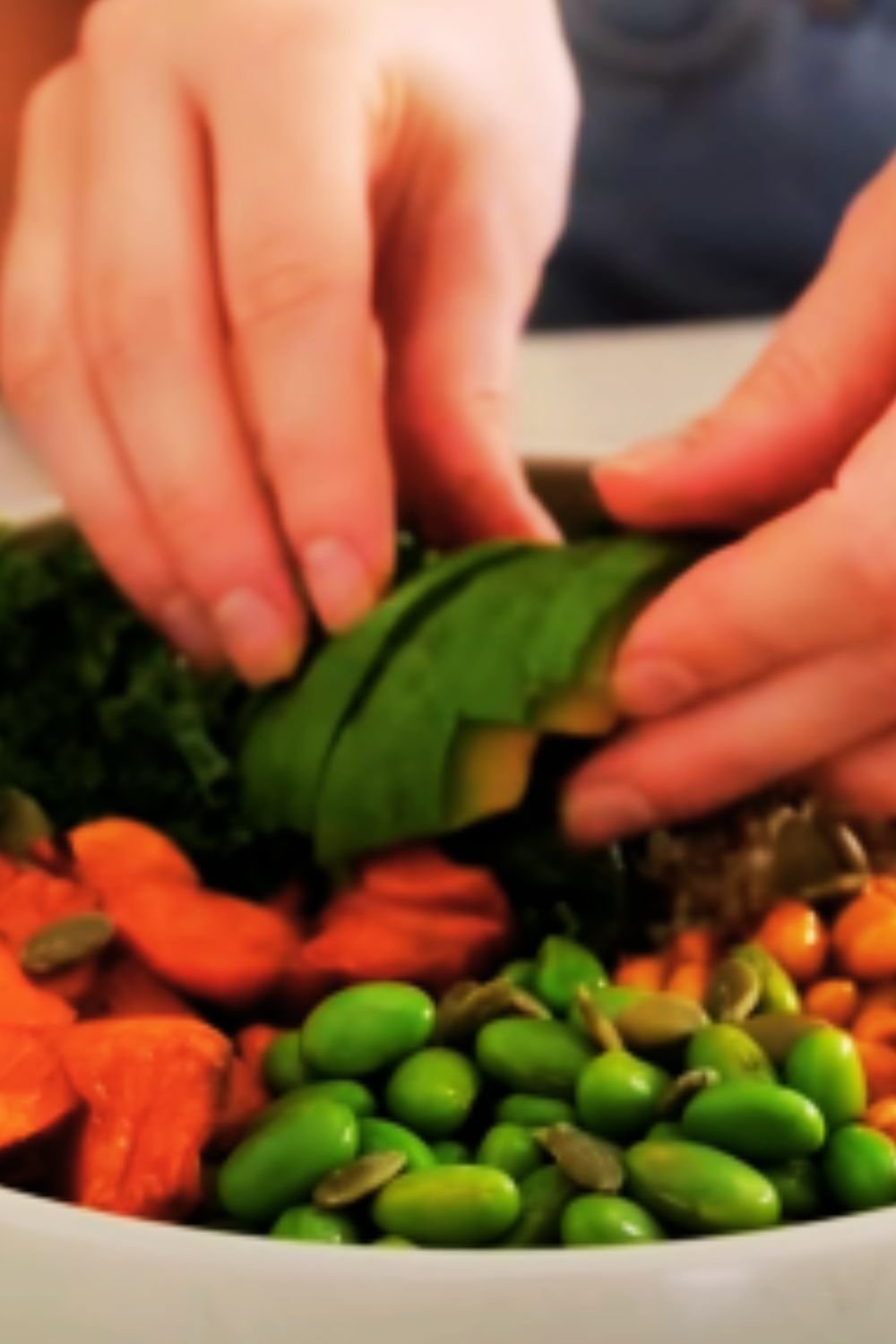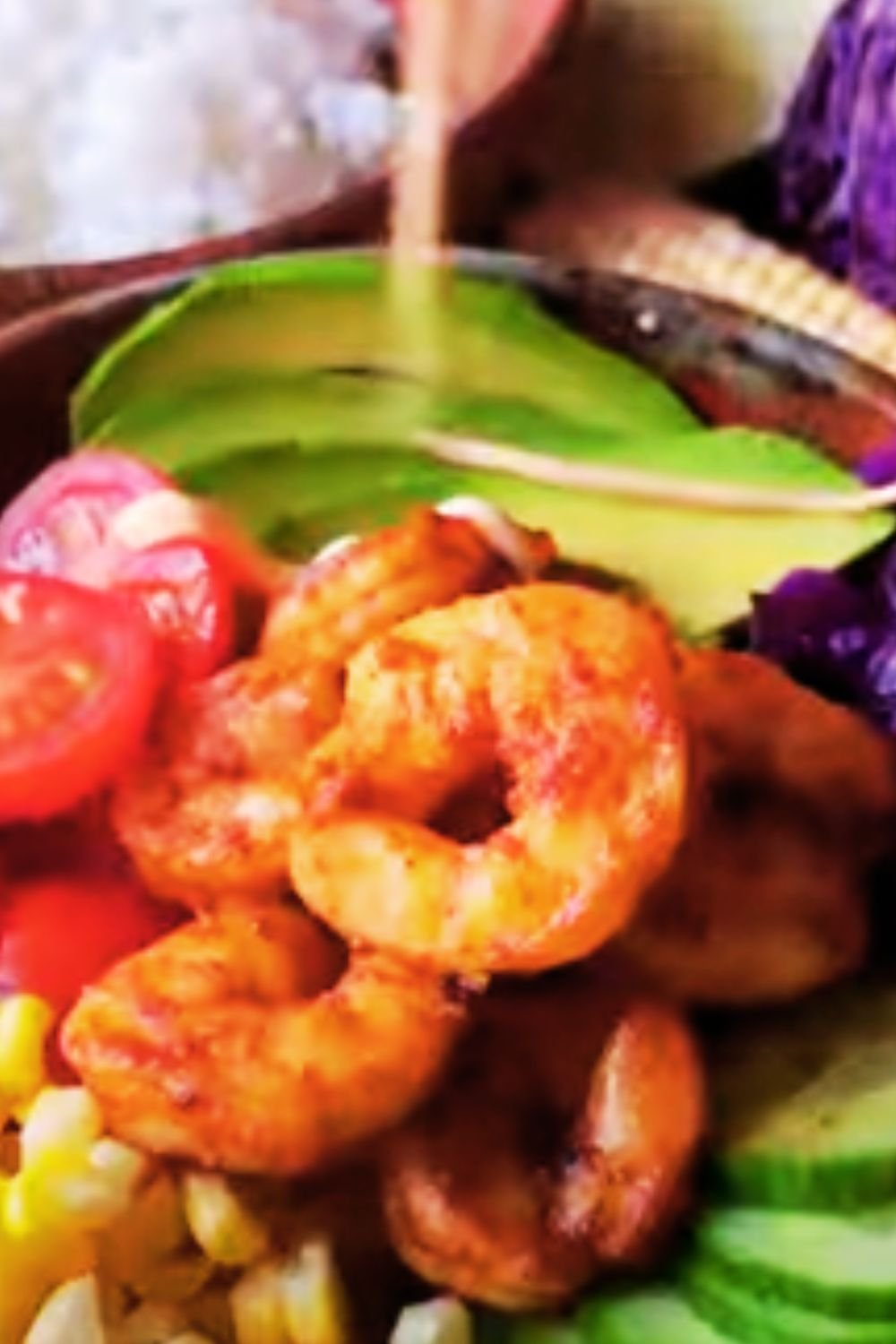There’s something magical about the combination of sweet honey and fiery heat that makes my taste buds dance with joy. When this delectable duo coats perfectly crispy chicken and gets paired with fresh vegetables and fluffy grains, you’ve got yourself a meal that’s not just satisfying—it’s downright crave-worthy. That’s exactly what these Hot Honey Chicken Bowls deliver: a perfect harmony of flavors and textures that will have you scraping the bowl clean and immediately planning when to make them again.
I stumbled upon this recipe combination during a particularly busy week when I needed something quick but impressive enough to break the monotony of my usual dinner rotation. Little did I know that this experimental dish would become a staple in my household, requested frequently by friends and family who’ve had the pleasure of trying it.
What makes these bowls truly special is their versatility. You can customize them endlessly based on seasonal produce, what’s in your refrigerator, or simply what you’re in the mood for. The constant stars of the show, however, are always the crispy chicken pieces glazed in that irresistible hot honey sauce—spicy, sweet, and utterly addictive.
What You’ll Need
For the Hot Honey Sauce:
- 1/2 cup honey (local wildflower honey works beautifully)
- 2-3 tablespoons hot sauce (I prefer Sriracha or Frank’s RedHot)
- 2 cloves garlic, minced
- 1 tablespoon apple cider vinegar
- 1/2 teaspoon smoked paprika
- 1/4 teaspoon cayenne pepper (adjust according to your heat preference)
- Pinch of salt
For the Chicken:
- 1.5 pounds boneless, skinless chicken thighs or breasts, cut into 1-inch pieces
- 1 cup all-purpose flour
- 1 tablespoon cornstarch
- 1 teaspoon garlic powder
- 1 teaspoon onion powder
- 1 teaspoon paprika
- 1/2 teaspoon black pepper
- 1 teaspoon salt
- 2 eggs, beaten
- 3 tablespoons milk
- Vegetable oil for frying
For the Bowls:
- 3 cups cooked grain of choice (rice, quinoa, farro, or cauliflower rice for a low-carb option)
- 4 cups mixed vegetables (suggestions: roasted broccoli, bell peppers, carrots, edamame, corn)
- 1 avocado, sliced
- 1/4 cup pickled red onions
- 1/4 cup fresh cilantro, chopped
- 2 green onions, thinly sliced
- Lime wedges for serving
- Sesame seeds for garnish
Equipment You’ll Need
- Large skillet or Dutch oven
- Mixing bowls
- Whisk
- Tongs
- Paper towel-lined plate
- Small saucepan
- Measuring cups and spoons
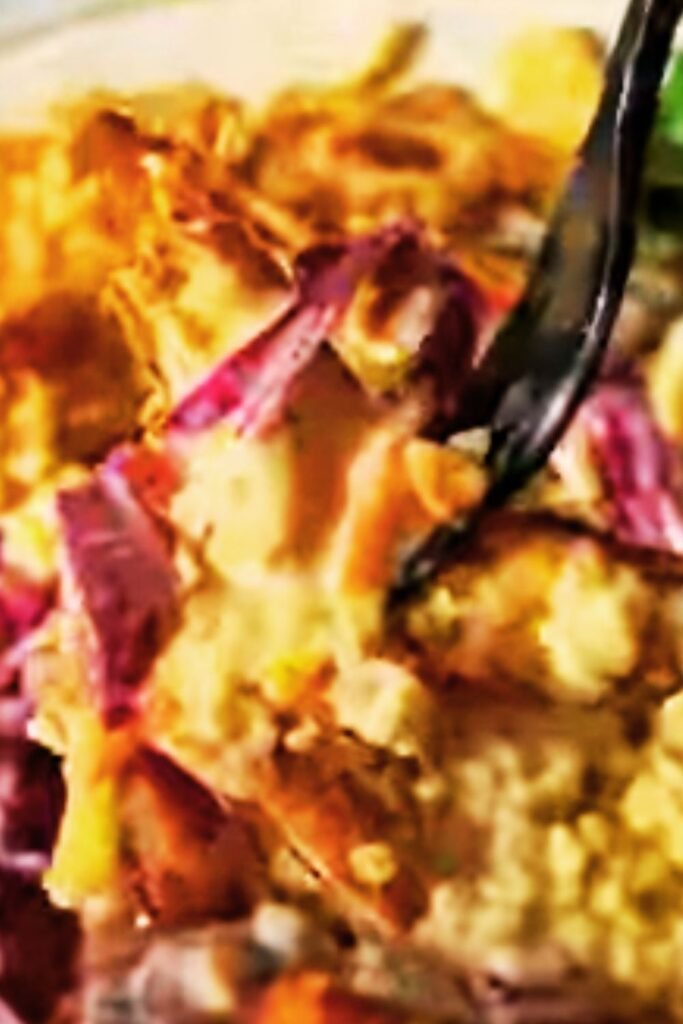
Step-by-Step Instructions
Preparing the Hot Honey Sauce
- Combine all sauce ingredients in a small saucepan over medium-low heat.
- Whisk until well combined and bring to a gentle simmer.
- Cook for 3-4 minutes, stirring occasionally, until the mixture has thickened slightly and the flavors have melded together.
- Remove from heat and set aside. The sauce will continue to thicken as it cools.
For the Crispy Chicken
- In a medium bowl, whisk together the flour, cornstarch, garlic powder, onion powder, paprika, pepper, and salt.
- In another bowl, beat the eggs with milk to create an egg wash.
- Pat the chicken pieces dry with paper towels (this is crucial for achieving maximum crispiness).
- Working in batches, dredge the chicken pieces in the flour mixture, then dip in the egg wash, and then back into the flour mixture, pressing gently to ensure the coating adheres.
- Heat about 1/2 inch of oil in a large skillet or Dutch oven over medium-high heat until it reaches approximately 350°F (175°C). If you don’t have a thermometer, you can test by dropping a small pinch of flour into the oil—it should sizzle immediately.
- Carefully add the coated chicken pieces to the hot oil, being careful not to overcrowd the pan (this will ensure each piece gets crispy rather than steamed).
- Fry for about 3-4 minutes per side, or until golden brown and cooked through (internal temperature should reach 165°F or 74°C).
- Transfer the fried chicken pieces to a paper towel-lined plate to drain excess oil.
- Once all chicken is fried, transfer to a large bowl and drizzle with about half of the hot honey sauce. Toss gently to coat all pieces evenly.
Assembling the Bowls
- Divide the cooked grain of your choice among 4 serving bowls.
- Arrange the mixed vegetables around the perimeter of each bowl.
- Place the hot honey glazed chicken in the center of each bowl.
- Add sliced avocado, pickled red onions, and a sprinkle of fresh cilantro and green onions.
- Drizzle the remaining hot honey sauce over everything.
- Garnish with sesame seeds and serve with lime wedges.
Make-Ahead and Storage Tips
- Prep components separately: You can cook the grains, prepare the vegetables, and make the hot honey sauce up to 2 days in advance. Store each component in separate airtight containers in the refrigerator.
- Hot honey sauce: This keeps wonderfully in the refrigerator for up to 2 weeks in an airtight container. It may crystallize slightly but can be brought back to life with gentle reheating.
- Reheating chicken: For the crispiest results, reheat leftover chicken in a 350°F (175°C) oven for 8-10 minutes. Avoid microwaving if possible, as it can make the coating soggy.
- Complete bowls: Assembled bowls can be stored in the refrigerator for up to 3 days. I recommend storing the avocado separately and adding it fresh when ready to eat to prevent browning.
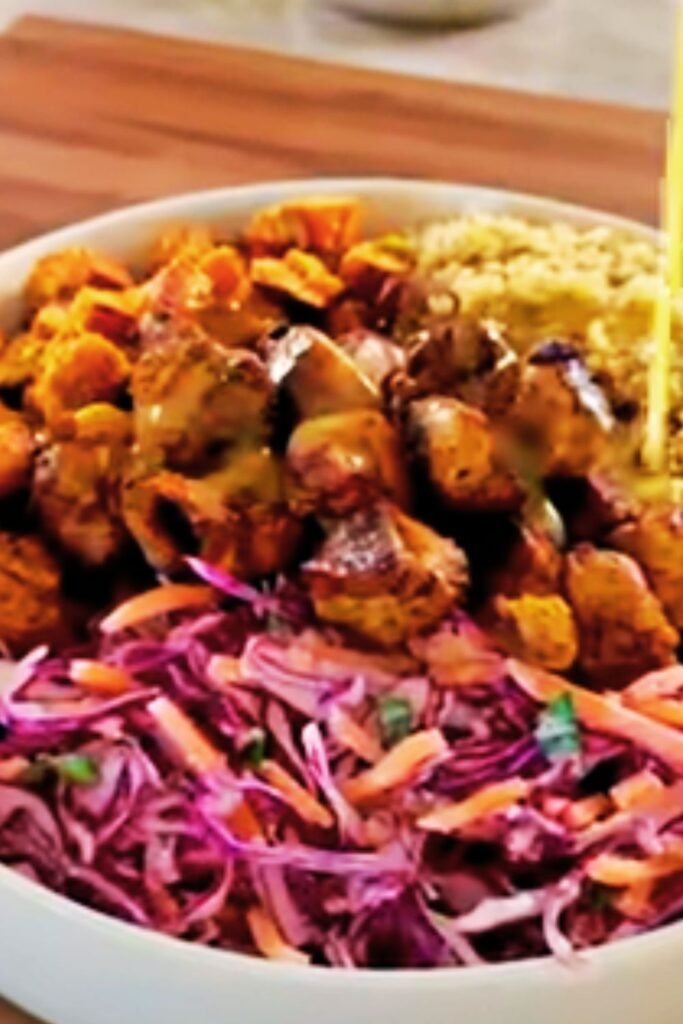
Customization Ideas
One of the reasons I absolutely adore these bowls is how endlessly customizable they are. Here are some variations to try:
Protein Options:
- Substitute tofu for a vegetarian version (press it well and follow the same coating and frying process)
- Use shrimp instead of chicken (reduce cooking time to about 2 minutes per side)
- Try pork tenderloin cut into bite-sized pieces
Grain Alternatives:
- Brown rice for extra fiber and nutty flavor
- Cilantro-lime rice for a southwestern twist
- Coconut rice for a tropical note
- Quinoa for added protein
- Farro or barley for a chewier texture
- Cauliflower rice for a lower-carb option
Vegetable Suggestions:
- Roasted sweet potatoes
- Sautéed zucchini and yellow squash
- Grilled corn kernels
- Cucumber ribbons for a cool, refreshing crunch
- Shredded red cabbage for color and crunch
- Roasted brussels sprouts
- Steamed asparagus
- Sugar snap peas
Sauce Variations:
- Add grated ginger to the hot honey sauce for an Asian-inspired flavor
- Mix in a tablespoon of peanut butter for a Thai twist
- Incorporate some lime zest for brightness
- Use different hot sauces to change the flavor profile (try gochujang for Korean-inspired bowls)
Nutritional Information
I believe in understanding what goes into our bodies, so here’s a breakdown of the approximate nutritional content per serving of these Hot Honey Chicken Bowls:
| Nutrient | Amount per Serving |
|---|---|
| Calories | 650 |
| Protein | 38g |
| Carbohydrates | 75g |
| Fiber | 8g |
| Sugar | 23g |
| Fat | 25g |
| Saturated Fat | 4g |
| Sodium | 820mg |
| Potassium | 780mg |
| Vitamin A | 45% DV |
| Vitamin C | 70% DV |
| Calcium | 8% DV |
| Iron | 20% DV |
Note: Values are approximate and will vary based on specific ingredients used and portion sizes.
Time-Saving Tips
If you’re like me and sometimes need to get dinner on the table quickly without sacrificing flavor, here are some shortcuts:
- Use pre-cut vegetables: Many grocery stores offer pre-chopped vegetables that can save significant prep time.
- Quick-cooking grains: Quinoa cooks in about 15 minutes, and microwaveable rice packets take just 90 seconds.
- Make the hot honey sauce ahead of time: It keeps well and having it ready to go speeds up the process.
- Sheet pan method: For a less hands-on approach, you can coat the chicken pieces in a bit of oil, season well, and bake at 425°F (220°C) for about 20 minutes, then toss with the hot honey sauce.
- Meal prep components: Spend an hour on Sunday preparing grains and chopping vegetables for quicker assembly during the week.
Serving Suggestions
These Hot Honey Chicken Bowls are quite complete meals on their own, but if you’re looking to round out the experience, consider these accompaniments:
- Crispy wonton strips or tortilla chips for added crunch
- A side of cooling cucumber-yogurt dip to balance the heat
- Fresh summer fruit like watermelon or pineapple
- Sparkling water with lime or a refreshing iced tea
- Homemade kombucha for a probiotic boost
- Fresh lemonade with mint
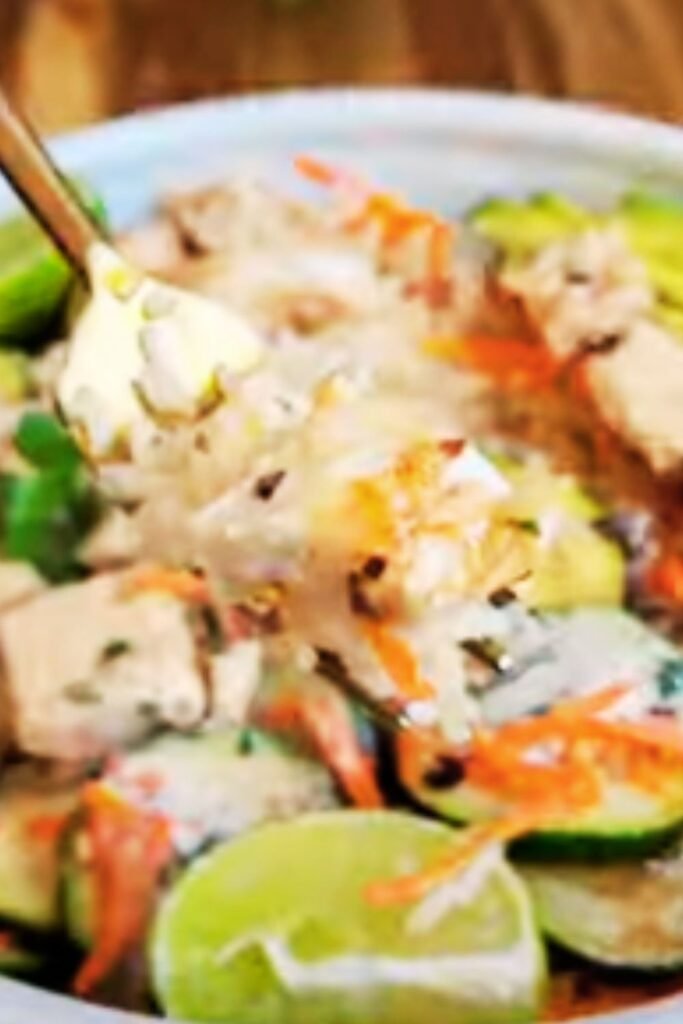
Common Questions and Troubleshooting
Q: My chicken coating isn’t staying crispy. What am I doing wrong? A: There are a few potential issues at play. First, make sure your oil is hot enough (350°F/175°C) before adding the chicken. Second, don’t overcrowd the pan, as this lowers the oil temperature and creates steam. Third, ensure your chicken pieces are thoroughly patted dry before coating. Finally, let the chicken rest on a wire rack rather than paper towels after frying to maintain maximum crispiness.
Q: Can I make this gluten-free? A: Absolutely! Simply substitute the all-purpose flour with a gluten-free flour blend or cornstarch. Make sure your hot sauce is also gluten-free, as some brands contain gluten additives.
Q: Is there a way to make this dish less spicy for kids or those sensitive to heat? A: Yes, you can easily adjust the heat level by reducing or omitting the cayenne pepper and using a milder hot sauce. For kids, I often make a separate batch with just honey, a tiny dash of hot sauce, garlic, and vinegar for a more mild but still flavorful sauce.
Q: Can I make this in an air fryer? A: Definitely! Preheat your air fryer to 400°F (200°C), spray the coated chicken pieces with a light coating of oil spray, and cook for about 12-15 minutes, turning halfway through. You’ll get wonderfully crispy chicken with significantly less oil.
Q: My hot honey sauce crystallized in the refrigerator. Is it still good? A: Yes, honey naturally crystallizes when stored in the refrigerator. Simply warm it gently in the microwave or on the stovetop until the crystals dissolve. It’s still perfectly good to use!
Q: Can I prep these bowls for lunches throughout the week? A: Absolutely! These make excellent meal prep lunches. I recommend storing the components separately if possible and assembling just before eating. If that’s not practical, fully assembled bowls (minus avocado) will still be delicious for up to 3 days.
The Science Behind the Perfect Hot Honey
The magic of this recipe lies in the complex interplay between sweetness and heat. Honey is primarily composed of the sugars fructose and glucose, which bind to our sweet taste receptors. Meanwhile, the capsaicin in hot sauce activates our pain receptors, creating that characteristic burn.
When these compounds combine, something fascinating happens: the sweetness of the honey initially hits your palate, followed by the gradual building heat of the capsaicin. This temporal separation of flavors creates a dynamic eating experience that keeps you coming back for more.
Additionally, the apple cider vinegar in the sauce serves two important purposes. First, its acidity balances the sweetness of the honey, creating a more complex flavor profile. Second, it helps to thin the honey slightly, making it easier to coat the chicken pieces evenly.
The smoked paprika adds another dimension with its complexity—a subtle smokiness that rounds out the flavor profile and adds depth to what would otherwise be a straightforward sweet-hot combination.
Why Hot Honey is Having a Moment
Over the past few years, hot honey has exploded in popularity in culinary circles, and for good reason. This versatile condiment bridges cultures and cuisines, drawing inspiration from Korean gochujang glazes, Italian calabrian chili infusions, and southern American hot pepper jellies.
Its appeal lies in its perfect balance of contrasting elements: sweet and spicy, complex yet approachable, traditional but innovative. In our increasingly global food culture, hot honey represents fusion done right—taking familiar elements and combining them in ways that feel both novel and comforting.
As someone who’s tested countless recipes, I can confidently say that hot honey is one of those rare ingredients that improves almost anything it touches—from pizza to fried chicken, roasted vegetables to cheese boards. These Hot Honey Chicken Bowls are just one delicious application of this transformative ingredient.
Final Thoughts
Creating these Hot Honey Chicken Bowls has become somewhat of a meditative practice for me. There’s something deeply satisfying about preparing each component—watching the chicken turn golden and crisp, stirring the hot honey as it bubbles and thickens, arranging the colorful vegetables in the bowl. It’s a reminder that cooking isn’t just about the end result but the journey of creating something with your hands.
What I love most about this recipe is how it brings people together. When I serve these bowls to friends and family, conversation inevitably slows as everyone savors that first bite. Then comes the discussion of flavors, the identifying of ingredients, the appreciative nods. Food has always been a universal language, and these bowls speak volumes.
I hope you enjoy making and eating these Hot Honey Chicken Bowls as much as I do. Remember that recipes are ultimately just guidelines—feel free to make this your own, adjusting flavors and components to suit your preferences and what’s available to you. The best dishes are born from a combination of solid techniques and personal creativity.
Now, go forth and create something delicious!
Q&A Section
Q: Can I make the hot honey sauce less spicy without losing flavor? A: Absolutely! The beauty of making your own hot honey sauce is that you can customize the heat level. Reduce the hot sauce and cayenne to just a small amount—enough to give a hint of warmth without the burn. You can also add a bit more garlic and a touch of ginger to build complexity without heat. Another option is to use milder hot sauces like Cholula or even just a dash of ancho chili powder instead of cayenne.
Q: I’m trying to reduce oil in my cooking. Is there another way to prepare the chicken? A: Yes! There are several less oil-intensive methods that still yield delicious results. My favorite alternative is baking: coat the chicken pieces as directed, place them on a wire rack set over a baking sheet, spray lightly with cooking spray, and bake at 425°F (220°C) for about 20 minutes or until crispy and cooked through. The air fryer method mentioned earlier is also excellent. For a completely different approach, you could marinate chicken pieces in some of the hot honey sauce (reserve some for serving), and then grill them for a smoky flavor profile.
Q: Are there any make-ahead components that freeze well? A: The coated, uncooked chicken freezes surprisingly well. Arrange the pieces on a parchment-lined baking sheet, freeze until solid, then transfer to a freezer bag. Cook from frozen by adding 5-7 minutes to the cooking time. The hot honey sauce can be frozen in ice cube trays for portion control, then transferred to freezer bags for up to 3 months. Most cooked grains also freeze beautifully—cook a big batch, portion into freezer bags, and reheat as needed.
Q: I’m counting macros. How can I make this more protein-forward? A: To boost the protein content, you have several options. First, increase the chicken amount per serving or choose a higher-protein grain like quinoa (8g protein per cup) instead of white rice (4g protein per cup). You could also add edamame to your vegetable mix, which offers about 17g of protein per cup. Another option is to include a sprinkle of hemp seeds as a garnish, adding about 10g of protein per 3 tablespoon serving. Finally, consider adding a dollop of Greek yogurt as a cooling element—it pairs wonderfully with the hot honey and adds approximately 15g of protein per 1/2 cup.
Q: How can I incorporate more seasonal vegetables throughout the year? A: One of the joys of bowl meals is their adaptability to seasonal produce. Here’s a quick seasonal guide:
- Spring: Asparagus, peas, radishes, spring onions, and tender leafy greens
- Summer: Zucchini, bell peppers, corn, cherry tomatoes, and cucumber
- Fall: Roasted butternut squash, brussels sprouts, cauliflower, and kale
- Winter: Roasted root vegetables like carrots and parsnips, cabbage, and hearty greens
Simply prepare these seasonal vegetables in a way that complements their natural flavors—quick blanching for spring vegetables, light sautéing for summer produce, and roasting for fall and winter vegetables.
Q: Do you have suggestions for turning this into a party-friendly format? A: These bowls translate beautifully to a DIY bowl bar for gatherings! Prepare all components and arrange them buffet-style in separate serving dishes. Include labels for any spicy or allergen-containing items. Provide smaller bowls for guests to create their own combinations. For easier serving, consider making the chicken pieces smaller (bite-sized) and offering toothpicks. This interactive serving style encourages mingling and conversation as guests compare their creations—plus, it accommodates different dietary preferences without requiring multiple separate dishes.

